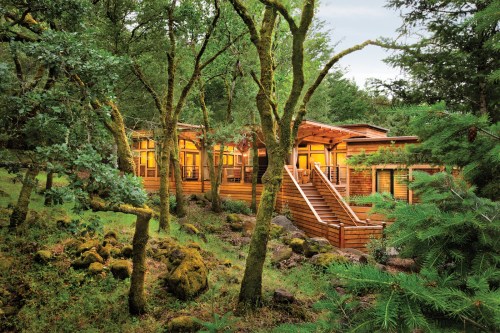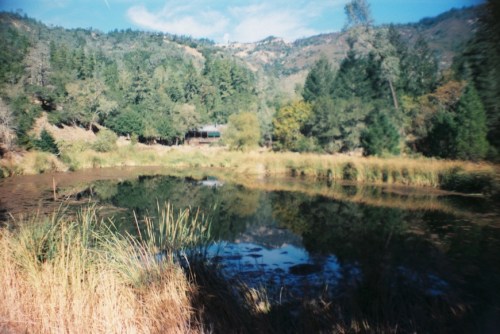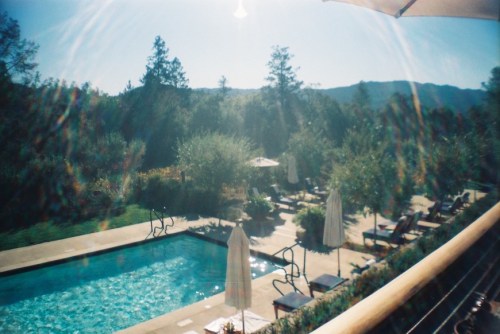I went on an unplugged retreat in Napa to find out whether silence really is golden
Curious what the ultiamte digital detox is like? One writer went on a silent retreat at Calistoga Ranch in California and has big-time takeaways to share.

I typically answer texts, emails, and calls whenever they come in. My mission to be digitally available at all times, though, compromises the attention I’m able to give to the people right in front of me, and to be honest, the pursuit of always being on was taking its toll. (I’ve often felt like I’m a iPhone alerts away from a meltdown.) So when I was invited to try Calistoga Ranch’s silent retreat program, “Sound Off” Quiet Retreat, I was intrigued.
“We created the ‘Sound Off’ Quiet Retreat to provide a solution for the luxury traveler who wishes to block out the everyday noise to truly experience extreme quiet, prioritize their wellness and reconnect with themselves and the outdoors,” says Avi Haksar, general manager and regional vice president of the wellness-forward boutique resort located in the middle of Napa Valley. “Our program caters to guests seeking out a quiet, rejuvenating solo trip or an opportunity to fully unplug with a partner in luxuriously relaxing setting.”
The experience (from $1,929 per night) is customized to each guest’s needs. That may mean complete silence, sans technology. Or perhaps a couple wants to unplug from everything but communicating with each other. Or, maybe, something else. For my trip, I aimed to avoid speaking and using any technology that could connect me with others.
My time on the silent retreat would mark not only my first-ever solo trip, but also the first instance I can remember being inaccessible for a few consecutive days. It sure sounded like the rejuvenating, relaxing dream come true I needed in order to give me a break from wedding planning, getting up to speed at a new job, and countless looming deadlines. But there was a big question I wasn’t sure I could answer: Would I even be able to make it through the trip being unplugged?
Digital detox: 101
For some, the concept of a digital detox means taking a hiatus from social media, and for others, it means completely going off the grid, without having access to anything that powers on or off. While there’s no right or wrong way to go about a digital detox, or a mandatory extent of extremeness required to make one legitimate, the desired goal is often the same. “It is an opportunity to go inward,” says Standard Dose meditation instructor, Kirat Randhawa. “When I am seeking clarity on something specific in my life, it is best to engage in a digital detox and allow my mind to be free from external distractions, thereby inviting my intuition to be heard with greater presence.”
I quickly learned that the setup of my trip—with no use of technology or words that could connect me with others—came with certain pros and cons. Below, find six takeaways from my solo silent retreat.

Takeaway 1: Preparation is key for a tech-free experience
In the weeks leading up to my silent retreat, I started weaning myself from social media (specifically Instagram) by limiting my use to only the weekends. Eventually I deleted the app temporarily, in hopes that this would minimize my habit of mindlessly scrolling. Quickly I was able to note the positive effects of this choice had on my productivity and attention span.
While I’m glad I went through with this weening exercise, in retrospect, I wish I committed to a few other preparations, as well. Namely, bring a watch (for most of the trip I had no idea what time it was and constantly relied on others) and an alarm clock (because, well, this one’s obvious). I also wish I was more mindful about checking the forecast, since the temperature ended up being warmer than I anticipated, (so I ultimately purchased both sandals and a swimsuit). This really distilled for me just how reliant I typically am on my phone.
I am glad I decided to pack a point-and-shoot camera, since I’d be without my phone during my silent retreat but still certainly wanted to document the stunning property.
Takeaway 2: The spa is the ultimate quiet escape
I saw a spa treatment on my printed schedule, which I brought everywhere with me, so as to explain my identity to staff members. I made my way to the lobby, where I awkwardly pointed to said printed schedule before being was whisked away via golf cart to the spa. I arrived for my treatment a full two hours early, allowing me to take advantage of the steam room, mineral pool, and hot tub that overlooks the sprawling property.
When it was time to start my “108 Reasons to Meditate” treatment, I first completed a brief quiz to identify my dosha—either Vata, Pitta, or Kapha—and gauge how I was feeling. Then, I was led through a guided meditation and set an intention for the treatment. I quickly slipped into a meditative state wherein I had trouble identifying exactly what was happening. Afterward, I was relaxed enough for bed, but it was time for dinner.
Takeaway 3: Meals alone are pretty great
To minimize my interactions with others during the silent retreat, all of my meals were pre-ordered either to my room or scheduled at the restaurant. Dining alone forced me to take time to not only eat my food but really enjoy it. And that endeavor was quite easy given the delicious dishes I enjoyed, like fresh day boat scallops, buttermilk pancakes, and pumpkin panna cotta.
This surprised me because mealtime, for me, is focused on community: It’s when I catch up with friends, family, or my fiancé. But, while I certainly do enjoy connecting with others over food, my shift in focus during the quiet retreat felt productive. I had nowhere else to be and no other demands on my attention, so I savored every bite, admired the detail and preparation that went into each dish, and often enjoyed a glass of wine.
Takeaway 4: Your journal may just become your new best friend
Journaling became my go-to activity for capturing miscellaneous thoughts—and that was new for me. Despite being a writer by trade, journaling at home usually was an activity I performed when I was stressed, not relaxed. Over the course of the retreat, I filled pages with my fears, goals, and a ha moments. Had I been connected the whole time? I may well have missed out on those mindful, introspective gains.
“Journaling is an intimate activity and invites a deeper expression of one’s feelings, including things that one may not have been conscious of before,” Randhawa says. “It invites one to go deeper into the experience and feel more connected to the memory that they are documenting.”
Takeaway 5: Fitness is a great solo activity
Calistoga Ranch has on-property hiking trails, but I opted for the gym’s Peloton, treadmill, weights, and rowing machine. I also had the chance to take a solo yoga class (the property offers daily classes). My instructor led me through a series of sun salutations, hip openers, and mantras to help me stay mindful.
Takeaway 6: Silence is golden, but everyone has to respect that
Most staff members seemed aware that I was participating in the silent retreat program, but, as expected, there were a few slips. (When booking a silent retreat at Calistoga ranch, a resort representative helps plan out the logistics and specifics, including noting which guests are on silent retreats prior to their arrival to help make the experience totally seamless.) When I accidentally ordered a bottle of wine meant to be shipped to my apartment, but it was mistakenly brought to my room, I had to use real spoken words to clear up the situation. Generally though, I could get by with the pen and paper I carried around.
However, since not every person on the property (like other guests) was also on a silent retreat, certain interactions certainly felt awkward. I found myself smiling, nodding, and ultimately avoiding the other guests who were trying to figure out why I was not responding to their small talk. One woman at the gym was particularly chatty, and since I wasn’t wearing headphones (given that I wasn’t listening to music), I couldn’t really subliminally dissuade her. In hindsight, maybe wearing a pin, a certain color, or being with a larger group would have been more ideal for communicating to others that I was on a silent retreat and not simply rude.

The bottom line on my silent retreat experience?
On my final day of the silent retreat, I powered on my phone to check in to my flight. I was greeted by a whopping 48 text messages, 308 emails, and voicemails from wedding vendors trying to reach me. I. was. stressed. I felt bombarded by the demand of deadlines and responding to messages. But at least I could turn off my phone again for a few more sweet hours—so that’s exactly what I did while trying to figure out how I’d get back into the swing of my digital life without added stress. “Ease yourself back into the world by reflecting on what you learned while on vacation and setting new boundaries and mindful practices to help you keep that vacation joy alive all year long,” says founder of I See You Wellness and healing artist, Mariam Mouna Guessous.
A through line of my reflection? Calistoga Ranch’s “Sound Off” Quiet Retreat is definitely a small slice of heaven in Napa Valley. Thankfully, though, it’s possible to achieve the well-being benefits affordably, as well. Below find six ways to unplug, sanctioned by Guessous and Randhawa, no travel needed:
1. Start (and end) your day with meditation
Meditation grounds us back to the present moment and increases our awareness of our surroundings. The more mindful we are, the less likely we are to reach for our phones.
2. Put your phone on airplane mode
Try for at least 60 mins before bed and if possible, 60 mins after you wake up while you get ready for your day.
3. Notify the people in your life
Tell your personal and professional contacts that you will be away in order to decrease the amount of incoming stimulation you receive from the outside world. With fewer people contacting you, you’ll have a lowered need to be on your phone.
4. Plan disconnected activities
Find things to do that force you to be fully present and your phone to be fully absent.
5. Carry other objects
Use these objects as resources that your phone would typically provide, like a camera, portable alarm clock, and journal. With other materials at the ready, you are less inclined to turn to the phone and get distracted by other notifications.
6. Have a real conversation
Why not spark a conversation with someone nearby? Be it a stranger, a friend or anyone else, having real conversations is food for the soul.
Did you know there’s science to back up digital detoxes making you happier? And they might be good news for your relationship, too.
Sign Up for Our Daily Newsletter
Get all the latest in wellness, trends, food, fitness, beauty, and more delivered right to your inbox.
Got it, you've been added to our email list.








